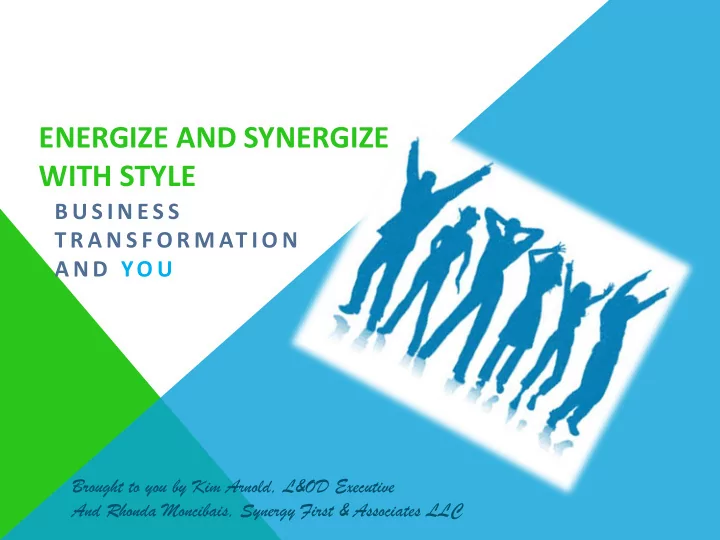

ENERGIZE AND SYNERGIZE WITH STYLE B U S I N E S S T R A N S F O R M AT I O N A N D YO U Brought to you by Kim Arnold, L&OD Executive And Rhonda Moncibais, Synergy First & Associates LLC
WHY ARE WE HERE? To expand our understanding of our role in managing change To explore your change style and its impact on organizational transformation Share frameworks, processes, and tools that guide change efforts to create Energy and Synergy 2
WHO ARE WE? Former Colleagues Client/ Long time Consultant Friends Relationship 3
FOUR PRIMARY ROLES OF L&OD PROFESSIONALS Change Change Change Change Participant Leader/Owner Educator Advisor 4
THE IMPACT OF CHANGE The Organization Your HR Team You Start Here It is business…It IS personal
THE REALITY TODAY Change Participant
TRANSITION IMPACTS PRODUCTIVITY (+) Excitement New Beginning Anticipation Problem High Energy Exploration Solving Learning Creativity Commitment Innovation Alignment Testing Hope Response Accomplishment The Neutral Zone Ambivalence Uncertainty Ending, Letting Go Relief Confusion Testing Anxiety Disorientation Unsure Resistance Concern Depression Denial Self-Doubt Anger Immobilization (-) Day X Day 1 Time Adapted from W. Bridges Transition Model 7
Neutral Zone 8
HOW TO MAKE IT HAPPEN? L&OD MUST BE: Resilient • Ability to recover and remain productive. • Understand how you adapt to change, Adaptable • Ability to read adjust your behavior • Able to align with “the new” to create synergy Authentic & • Bring your authentic self to lead others • Energized about what is coming - If you can’t walk Engaged the talk, they never will.
WE ALL HAVE A CHANGE STYLE Your Chang nge Style Your Chang nge Style Does: s: Doe oes N Not: Offer a r an e expl planation on of p preferr rred Present a t a righ ght t or wrong, g, “ “bett tter” o or style le of i initi tiati ting g and d deali ling w g with th “wor orse se” c change style chan ange Desc scri ribe change s style p prefere rences s Measu sure re y your r compe petence that a are re m mor ore pe pers rsonality initi tiati ting g and m managi ging c change ge influence ced than an s situat ational al Create a an appre preciation on f for r change- Limit imit y you t to predetermi mined style d diversi rsity respon sponses t s to change Discovery Learning
Poll: Where do you stand? B: 5 or more ‘B’ Responses A: 5 or more ‘A’ Responses C: 3-4 of each A&B Conserver Pragmatist Originator 66 56 42 28 13 7 0 7 13 28 42 56 66 25% 50% 25%
CHANGE STYLE PREFERENCE CONSERVERS Honor Tradition Prefer change that is incremental Enjoy Predictability Appear Disciplined & Organized
CHANGE STYLE PREFERENCE ORIGINATORS Challenge the structure Prefer change that is expansive Enjoy risk and uncertainty May appear visionary but might miss important details
CHANGE STYLE PREFERENCE PRAGMA GMATISTS Focused on Results Prefer change that is practical Take a middle-of-the-road approach Are open to both sides of an argument
PERCEPTIONS “You are fair, compassionate, intelligent, but unfortunately, you are perceived by others as biased, calloused, and dim.”
PERCEPTIONS yielding to authority having their head in ORIGINATORS might see the sand CONSERVERS as: bureaucratic preferring the status quo lacking new ideas avoiding risk lacking innovation dogmatic
PERCEPTIONS divisive impulsive lacking appreciation of CONSERVERS might see tested ways of getting things done ORIGINATORS as: starting but not finishing projects not interested in follow through wanting change for the sake of change not understanding how things get done
PERCEPTIONS compromising PRAGMATISTS might see mediating CONSERVERS and indecisive ORIGINATORS as: easily influenced noncommittal hiding behind team needs
CASE STUDY EXAMPLE 20
CONTINUUM Can this organization drive Radical Change? Conserver Pragmatist Originator 66 56 42 28 13 7 0 7 13 28 42 56 66 25% 50% 25%
SUGGESTIONS FOR INCREASING FLEXIBILITY AND AVOIDING STYLE TRAPS Consult with a person you believe Make efforts to understand the to have a change style different perspectives of those with styles from yours before proceeding. other than your own. Imagine “putting on a hat” of another style – especially if you Solicit feedback and suggestions. believe the change requires a different approach. Step back and be aware of your initial reaction in a situation, especially when you are aware of having an emotional response.
L&OD DRIVING CHANGE Change Leader/ Consider: Owner Are you using good change management framework? Do you need to engage outside resources? Are we considering the organization’s tolerance for change? 23
CHANGE LEADERSHIP REQUIRES DIFFERENT CAPABILITIES Strategic Change Management Management “Think” “Do” Transition Management Industry Knowledge Project Management “Feel” Analytical Skills Communication Skills Financial Acumen People Skills Process Expertise External Focus Listening\Coaching Long-Term View Internal Focus Creativity Decisiveness Medium-Term View Individual Focus Committed Tenacity Short-Term View Patience Passionate Tolerant
EDUCATE OURSELVES TO EDUCATE OTHERS Change Educator Certification programs Mentors External Expertise Experience 25
TOOL - CHANGE LEADERSHIP FRAMEWORK Stage 1: Make the Case Stage 2: Design the Change Increase Urgency Stage 3: Execute the Change Get the Right Get the Vision Right Leaders Involved Stage 4: Make It Stick Develop a Roadmap Communicate for Engagement Create Short- Term Wins Empower Action Create a New Culture Based on John Kotter’s “Formula” for Change
Change Advisor 27
28
BACKUP 29
INTERVENE BEFORE WE FAIL Complacency Make the Case False Starts Confusion Design the Change Misalignment Frustration Execute the Change Resistance Cynicism Make it Stick Loss of Momentum
Recommend
More recommend